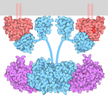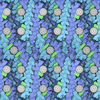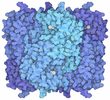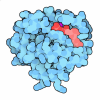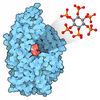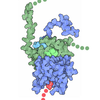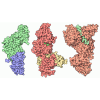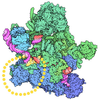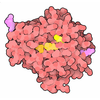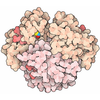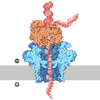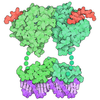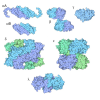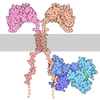+ Open data
Open data
- Basic information
Basic information
| Entry | Database: PDB / ID: 8gft | |||||||||||||||
|---|---|---|---|---|---|---|---|---|---|---|---|---|---|---|---|---|
| Title | Hsp90 provides platform for CRaf dephosphorylation by PP5 | |||||||||||||||
 Components Components |
| |||||||||||||||
 Keywords Keywords | CHAPERONE / kinase / phosphatase / complex | |||||||||||||||
| Function / homology |  Function and homology information Function and homology informationregulation of type II interferon-mediated signaling pathway / response to arachidonate / HSP90-CDC37 chaperone complex / death-inducing signaling complex assembly / negative regulation of proteasomal protein catabolic process / Aryl hydrocarbon receptor signalling / aryl hydrocarbon receptor complex / : / peptidyl-serine dephosphorylation / peptidyl-threonine dephosphorylation ...regulation of type II interferon-mediated signaling pathway / response to arachidonate / HSP90-CDC37 chaperone complex / death-inducing signaling complex assembly / negative regulation of proteasomal protein catabolic process / Aryl hydrocarbon receptor signalling / aryl hydrocarbon receptor complex / : / peptidyl-serine dephosphorylation / peptidyl-threonine dephosphorylation / intermediate filament cytoskeleton organization / dynein axonemal particle / histone methyltransferase binding / receptor ligand inhibitor activity / type B pancreatic cell proliferation / regulation of Rho protein signal transduction / SHOC2 M1731 mutant abolishes MRAS complex function / Gain-of-function MRAS complexes activate RAF signaling / ATP-dependent protein binding / Rap1 signalling / positive regulation of protein localization to cell surface / regulation of cell motility / protein kinase regulator activity / insulin secretion involved in cellular response to glucose stimulus / protein folding chaperone complex / response to morphine / Negative feedback regulation of MAPK pathway / telomerase holoenzyme complex assembly / post-transcriptional regulation of gene expression / Respiratory syncytial virus genome replication / GP1b-IX-V activation signalling / Uptake and function of diphtheria toxin / IFNG signaling activates MAPKs / protein serine/threonine phosphatase activity / Drug-mediated inhibition of ERBB2 signaling / Resistance of ERBB2 KD mutants to trastuzumab / Resistance of ERBB2 KD mutants to sapitinib / Resistance of ERBB2 KD mutants to tesevatinib / Resistance of ERBB2 KD mutants to neratinib / Resistance of ERBB2 KD mutants to osimertinib / Resistance of ERBB2 KD mutants to afatinib / Resistance of ERBB2 KD mutants to AEE788 / Resistance of ERBB2 KD mutants to lapatinib / Drug resistance in ERBB2 TMD/JMD mutants / regulation of cyclin-dependent protein serine/threonine kinase activity / myosin phosphatase activity / TPR domain binding / protein-serine/threonine phosphatase / ERBB2-ERBB3 signaling pathway / positive regulation of transforming growth factor beta receptor signaling pathway / Assembly and release of respiratory syncytial virus (RSV) virions / face development / dendritic growth cone / pseudopodium / phosphatase activity / regulation of type I interferon-mediated signaling pathway / regulation of cell differentiation / : / neurotrophin TRK receptor signaling pathway / somatic stem cell population maintenance / thyroid gland development / Sema3A PAK dependent Axon repulsion / The NLRP3 inflammasome / phosphoprotein phosphatase activity / regulation of protein ubiquitination / HSF1-dependent transactivation / response to unfolded protein / extrinsic apoptotic signaling pathway via death domain receptors / MAP kinase kinase kinase activity / HSF1 activation / telomere maintenance via telomerase / chaperone-mediated protein complex assembly / Attenuation phase / protein targeting / negative regulation of protein-containing complex assembly / RHOBTB2 GTPase cycle / cellular response to interleukin-4 / axonal growth cone / type II interferon-mediated signaling pathway / Purinergic signaling in leishmaniasis infection / Schwann cell development / DNA polymerase binding / activation of adenylate cyclase activity / negative regulation of extrinsic apoptotic signaling pathway via death domain receptors / supramolecular fiber organization / chaperone-mediated protein folding / Signaling by ERBB2 / negative regulation of proteasomal ubiquitin-dependent protein catabolic process / heat shock protein binding / HSP90 chaperone cycle for steroid hormone receptors (SHR) in the presence of ligand / nitric-oxide synthase regulator activity / response to muscle stretch / protein folding chaperone / CD209 (DC-SIGN) signaling / myelination / Constitutive Signaling by Overexpressed ERBB2 / ESR-mediated signaling / : / insulin-like growth factor receptor signaling pathway / thymus development Similarity search - Function | |||||||||||||||
| Biological species |  Homo sapiens (human) Homo sapiens (human) | |||||||||||||||
| Method | ELECTRON MICROSCOPY / single particle reconstruction / cryo EM / Resolution: 3.8 Å | |||||||||||||||
 Authors Authors | Jaime-Garza, M. / Nowotny, C.A. / Coutandin, D. / Wang, F. / Tabios, M. / Agard, D.A. | |||||||||||||||
| Funding support |  United States, 4items United States, 4items
| |||||||||||||||
 Citation Citation |  Journal: Nat Commun / Year: 2023 Journal: Nat Commun / Year: 2023Title: Hsp90 provides a platform for kinase dephosphorylation by PP5. Authors: Maru Jaime-Garza / Carlos A Nowotny / Daniel Coutandin / Feng Wang / Mariano Tabios / David A Agard /  Abstract: The Hsp90 molecular chaperone collaborates with the phosphorylated Cdc37 cochaperone for the folding and activation of its many client kinases. As with many kinases, the Hsp90 client kinase CRaf is ...The Hsp90 molecular chaperone collaborates with the phosphorylated Cdc37 cochaperone for the folding and activation of its many client kinases. As with many kinases, the Hsp90 client kinase CRaf is activated by phosphorylation at specific regulatory sites. The cochaperone phosphatase PP5 dephosphorylates CRaf and Cdc37 in an Hsp90-dependent manner. Although dephosphorylating Cdc37 has been proposed as a mechanism for releasing Hsp90-bound kinases, here we show that Hsp90 bound kinases sterically inhibit Cdc37 dephosphorylation indicating kinase release must occur before Cdc37 dephosphorylation. Our cryo-EM structure of PP5 in complex with Hsp90:Cdc37:CRaf reveals how Hsp90 both activates PP5 and scaffolds its association with the bound CRaf to dephosphorylate phosphorylation sites neighboring the kinase domain. Thus, we directly show how Hsp90's role in maintaining protein homeostasis goes beyond folding and activation to include post translationally modifying its client kinases. | |||||||||||||||
| History |
|
- Structure visualization
Structure visualization
| Structure viewer | Molecule:  Molmil Molmil Jmol/JSmol Jmol/JSmol |
|---|
- Downloads & links
Downloads & links
- Download
Download
| PDBx/mmCIF format |  8gft.cif.gz 8gft.cif.gz | 752.8 KB | Display |  PDBx/mmCIF format PDBx/mmCIF format |
|---|---|---|---|---|
| PDB format |  pdb8gft.ent.gz pdb8gft.ent.gz | 617.5 KB | Display |  PDB format PDB format |
| PDBx/mmJSON format |  8gft.json.gz 8gft.json.gz | Tree view |  PDBx/mmJSON format PDBx/mmJSON format | |
| Others |  Other downloads Other downloads |
-Validation report
| Summary document |  8gft_validation.pdf.gz 8gft_validation.pdf.gz | 1.3 MB | Display |  wwPDB validaton report wwPDB validaton report |
|---|---|---|---|---|
| Full document |  8gft_full_validation.pdf.gz 8gft_full_validation.pdf.gz | 1.3 MB | Display | |
| Data in XML |  8gft_validation.xml.gz 8gft_validation.xml.gz | 67.9 KB | Display | |
| Data in CIF |  8gft_validation.cif.gz 8gft_validation.cif.gz | 105.9 KB | Display | |
| Arichive directory |  https://data.pdbj.org/pub/pdb/validation_reports/gf/8gft https://data.pdbj.org/pub/pdb/validation_reports/gf/8gft ftp://data.pdbj.org/pub/pdb/validation_reports/gf/8gft ftp://data.pdbj.org/pub/pdb/validation_reports/gf/8gft | HTTPS FTP |
-Related structure data
| Related structure data |  29984MC  8gaeC C: citing same article ( M: map data used to model this data |
|---|---|
| Similar structure data | Similarity search - Function & homology  F&H Search F&H Search |
- Links
Links
- Assembly
Assembly
| Deposited unit | 
|
|---|---|
| 1 |
|
- Components
Components
-Protein , 4 types, 5 molecules ABCDE
| #1: Protein | Mass: 83595.484 Da / Num. of mol.: 2 Source method: isolated from a genetically manipulated source Details: Hsp90 sequence with HRV 3C cleavage site and one residue glycine linker. Source: (gene. exp.)  Homo sapiens (human) / Gene: HSP90AB1, HSP90B, HSPC2, HSPCB / Production host: Homo sapiens (human) / Gene: HSP90AB1, HSP90B, HSPC2, HSPCB / Production host:  #2: Protein | | Mass: 45352.223 Da / Num. of mol.: 1 Source method: isolated from a genetically manipulated source Details: Cdc37 followed by HRV 3C cleavage site at C-terminal of construct. Source: (gene. exp.)  Homo sapiens (human) / Gene: CDC37, CDC37A / Production host: Homo sapiens (human) / Gene: CDC37, CDC37A / Production host:  #3: Protein | | Mass: 34926.168 Da / Num. of mol.: 1 Source method: isolated from a genetically manipulated source Details: CRaf/Raf1 kinase domain followed by a LPESG linker, Strep Tag II sequence (WSHPQFEK) and a HRV 3C cleavage site (LEVLFQ). Source: (gene. exp.)  Homo sapiens (human) / Gene: RAF1, RAF / Production host: Homo sapiens (human) / Gene: RAF1, RAF / Production host:  References: UniProt: P04049, non-specific serine/threonine protein kinase #4: Protein | | Mass: 57184.730 Da / Num. of mol.: 1 / Mutation: H304A Source method: isolated from a genetically manipulated source Details: HRV 3C cleavage site followed by GS linker and PP5 sequence. Source: (gene. exp.)  Homo sapiens (human) / Gene: PPP5C, PPP5 / Plasmid: pQiq / Production host: Homo sapiens (human) / Gene: PPP5C, PPP5 / Plasmid: pQiq / Production host:  References: UniProt: P53041, protein-serine/threonine phosphatase |
|---|
-Non-polymers , 5 types, 8 molecules 








| #5: Chemical | ChemComp-ADP / | ||||||
|---|---|---|---|---|---|---|---|
| #6: Chemical | | #7: Chemical | #8: Chemical | ChemComp-ATP / | #9: Chemical | |
-Details
| Has protein modification | Y |
|---|
-Experimental details
-Experiment
| Experiment | Method: ELECTRON MICROSCOPY |
|---|---|
| EM experiment | Aggregation state: PARTICLE / 3D reconstruction method: single particle reconstruction |
- Sample preparation
Sample preparation
| Component |
| ||||||||||||||||||||||||||||||
|---|---|---|---|---|---|---|---|---|---|---|---|---|---|---|---|---|---|---|---|---|---|---|---|---|---|---|---|---|---|---|---|
| Molecular weight |
| ||||||||||||||||||||||||||||||
| Source (natural) |
| ||||||||||||||||||||||||||||||
| Source (recombinant) |
| ||||||||||||||||||||||||||||||
| Buffer solution | pH: 7.5 | ||||||||||||||||||||||||||||||
| Buffer component |
| ||||||||||||||||||||||||||||||
| Specimen | Conc.: 0.09 mg/ml / Embedding applied: NO / Shadowing applied: NO / Staining applied: NO / Vitrification applied: YES | ||||||||||||||||||||||||||||||
| Specimen support | Grid material: GOLD / Grid mesh size: 300 divisions/in. / Grid type: Quantifoil R1.2/1.3 | ||||||||||||||||||||||||||||||
| Vitrification | Cryogen name: ETHANE / Humidity: 100 % / Chamber temperature: 283.15 K Details: 3uL OF SAMPLE, 10C, 100% HUMIDITY, 30S WAIT TIME, 3S BLOT TIME, -2 BLOT FORCE |
- Electron microscopy imaging
Electron microscopy imaging
| Experimental equipment |  Model: Titan Krios / Image courtesy: FEI Company |
|---|---|
| Microscopy | Model: FEI TITAN KRIOS |
| Electron gun | Electron source:  FIELD EMISSION GUN / Accelerating voltage: 300 kV / Illumination mode: FLOOD BEAM FIELD EMISSION GUN / Accelerating voltage: 300 kV / Illumination mode: FLOOD BEAM |
| Electron lens | Mode: BRIGHT FIELD / Nominal magnification: 105000 X / Nominal defocus max: 1800 nm / Nominal defocus min: 800 nm |
| Specimen holder | Cryogen: NITROGEN / Specimen holder model: FEI TITAN KRIOS AUTOGRID HOLDER |
| Image recording | Electron dose: 69 e/Å2 / Film or detector model: GATAN K3 BIOQUANTUM (6k x 4k) / Num. of real images: 4160 |
- Processing
Processing
| Software | Name: PHENIX / Version: 1.20.1_4487: / Classification: refinement | ||||||||||||||||||||||||||||||||||||||||||||||||||||||||||||
|---|---|---|---|---|---|---|---|---|---|---|---|---|---|---|---|---|---|---|---|---|---|---|---|---|---|---|---|---|---|---|---|---|---|---|---|---|---|---|---|---|---|---|---|---|---|---|---|---|---|---|---|---|---|---|---|---|---|---|---|---|---|
| EM software |
| ||||||||||||||||||||||||||||||||||||||||||||||||||||||||||||
| CTF correction | Type: PHASE FLIPPING AND AMPLITUDE CORRECTION | ||||||||||||||||||||||||||||||||||||||||||||||||||||||||||||
| Particle selection | Num. of particles selected: 3730385 / Details: Gaussian blob particle picking in cryosparc. | ||||||||||||||||||||||||||||||||||||||||||||||||||||||||||||
| 3D reconstruction | Resolution: 3.8 Å / Resolution method: FSC 0.143 CUT-OFF / Num. of particles: 545237 / Algorithm: FOURIER SPACE Details: Three different maps were used for final composite map: Hsp90:Cdc37: 288k particles, 3.2A PP5 TPR: 215k particles, 3.3A PP5 catalytic domain: 43k particles, 3.8A Composite half maps were ...Details: Three different maps were used for final composite map: Hsp90:Cdc37: 288k particles, 3.2A PP5 TPR: 215k particles, 3.3A PP5 catalytic domain: 43k particles, 3.8A Composite half maps were used to get the final resolution in Relion PostProcessing. All original maps provided in the "Related entries" tab. Num. of class averages: 3 / Symmetry type: POINT | ||||||||||||||||||||||||||||||||||||||||||||||||||||||||||||
| Atomic model building | Protocol: RIGID BODY FIT Details: This model was built using rigid body docking in Chimera and ChimeraX for all main chains, and RosettaCM to add remaining fragments not included in previous models. Refinement was done using ...Details: This model was built using rigid body docking in Chimera and ChimeraX for all main chains, and RosettaCM to add remaining fragments not included in previous models. Refinement was done using iterative Phenix and RosettaRelax, and finalized with ISOLDE. | ||||||||||||||||||||||||||||||||||||||||||||||||||||||||||||
| Atomic model building |
| ||||||||||||||||||||||||||||||||||||||||||||||||||||||||||||
| Refine LS restraints |
|
 Movie
Movie Controller
Controller








 PDBj
PDBj